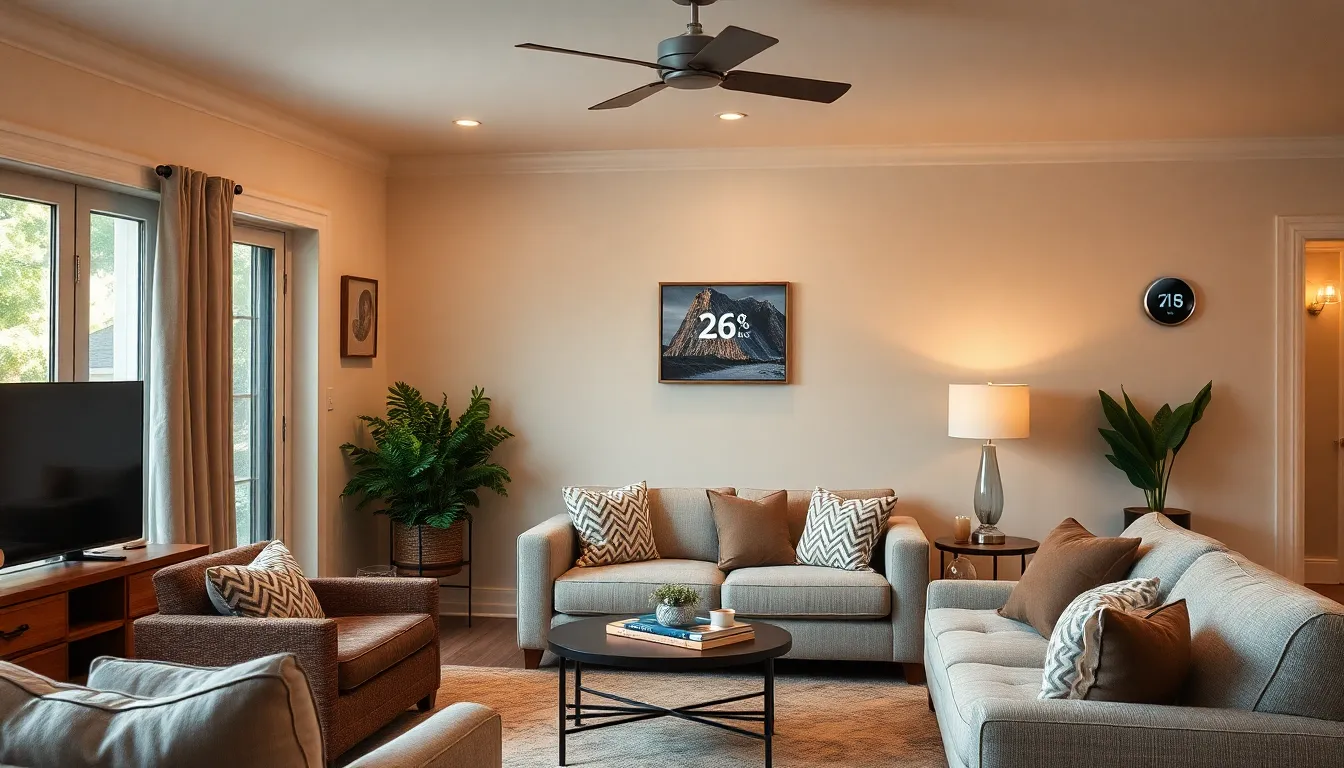Imagine walking into your home and having the lights dim, the thermostat adjust, and your favorite playlist start playing—all without lifting a finger. Sounds like something out of a sci-fi movie, right? Welcome to the world of home automation management, where technology turns your humble abode into a smart haven.
Home automation isn’t just for tech enthusiasts or the Jetsons anymore. It’s for everyone who wants to simplify their life, save time, and maybe even impress the neighbors with their futuristic setup. With the right tools, managing your home can be as easy as saying, “Hey Google, make it cozy!” Dive into this article to discover how home automation can transform your living space into a seamless blend of comfort and convenience. Who knew living like a robot could feel so good?
Table of Contents
ToggleOverview of Home Automation Management
Home automation management involves integrating various technologies to create a seamless, efficient living environment. This approach enhances convenience, security, and energy efficiency throughout a home.
Definition and Importance
Home automation refers to the use of technology to control household systems through a unified interface. This concept enhances daily living by enabling individuals to manage lighting, heating, and security systems remotely or automatically. Implementing home automation solutions significantly increases comfort and reliability, making life easier for everyone in a household. With the rise of smart devices, adopting home automation has become increasingly important. It not only improves energy efficiency but also contributes to enhanced safety and a modern lifestyle.
Key Components of Home Automation
Several key components make up home automation systems. Smart lighting allows users to control brightness and color through apps or sensors. Smart thermostats adjust heating and cooling based on user preferences and occupancy patterns, promoting energy savings. Security systems, which include smart cameras and alarms, enhance overall home safety. Smart speakers serve as centralized hubs, enabling voice control over other devices. Sensors monitor motion, temperature, and humidity, providing real-time data for more informed decisions. Together, these elements create an interconnected ecosystem that simplifies management and improves daily living experiences.
Benefits of Home Automation Management

Home automation management offers a multitude of advantages that enhance daily living. This technology provides users with increased security, energy savings, and unparalleled comfort.
Enhanced Security
Enhanced security remains a primary benefit of home automation management. Smart security systems allow users to monitor their homes remotely through cameras and sensors. Notifications alert users of unusual activities, ensuring peace of mind. Automated locks offer convenience when entering or exiting, reinforcing overall safety. Integration with security alarms can deter potential intruders, boosting protection significantly. These features create a safer living environment for everyone.
Energy Efficiency
Energy efficiency is another crucial advantage of home automation management. Smart thermostats adjust heating and cooling based on household patterns, maintaining optimal comfort while reducing energy costs. Automating lights ensures they turn off when not in use, further conserving energy. Appliances can operate during off-peak hours, maximizing savings. Data analytics helps identify energy consumption trends, allowing users to make informed adjustments. Consequently, households not only reduce their ecological footprint but also save on utility bills.
Convenience and Comfort
Convenience and comfort define the core experience of home automation management. Homeowners can control devices from anywhere using mobile apps or voice commands. Automated schedules for lighting, climate control, and entertainment deliver personalized living experiences. Smart home systems adapt to preferences, providing an intuitive experience. Integrated appliances streamline daily tasks, making life simpler. Enjoying a more comfortable home environment becomes effortless with the harmony between technology and everyday routines.
Popular Home Automation Systems
Home automation systems enhance convenience and efficiency in modern living. Various options cater to different needs and preferences.
Smart Hubs
Smart hubs serve as central control points for all connected devices. They streamline management of various systems, such as lighting and security, allowing users to control everything from one interface. Popular choices include Samsung SmartThings and Amazon Echo Plus. Compatibility with numerous devices improves user experience, simplifying interactions. Devices communicate seamlessly through these hubs, leading to enhanced functionality and convenience in daily life.
Smart Sensors and Devices
Smart sensors and devices play crucial roles in automation. They include motion detectors, door/window sensors, and smart cameras, each providing added security and monitoring. Many sensors trigger actions based on specific conditions, such as turning on lights when someone enters a room. Popular brands like Philips Hue and Ring offer products that integrate well with various systems. This integration allows for real-time data collection and improved resource management throughout the home.
Voice Assistants
Voice assistants elevate home automation to a new level. Users interact using natural language, making it easy to control devices hands-free. Amazon Alexa and Google Assistant are popular choices that connect with numerous platforms. These assistants enable users to set reminders, check the weather, or adjust lighting with simple voice commands. Their ability to integrate with other smart devices enhances user experience and promotes a more dynamic living environment.
Challenges in Home Automation Management
Home automation management presents several challenges that individuals encounter when integrating smart technologies.
Compatibility Issues
Integration of devices from different manufacturers often leads to compatibility issues. Smart products may use diverse protocols, creating synchronization problems. Users may find it difficult to connect devices if they’re not compatible with the central hub. This lack of standardization complicates the seamless experience that many expect. Ensuring all products communicate effectively requires thorough research and planning before purchase. Proper selection of compatible devices increases the likelihood of a smooth installation.
Privacy Concerns
Privacy remains a significant challenge in home automation management. Smart devices frequently collect personal data, raising concerns about data security among users. Unauthorized access to these devices can lead to privacy breaches. Users must understand the importance of securing their networks to mitigate these risks. Regularly updating device software provides an added layer of protection. Awareness of each device’s privacy policy is crucial for safeguarding personal information.
Installation Costs
Installation costs can pose a barrier to home automation management. Initial expenses may include purchasing devices, hubs, and additional equipment required for setup. Professional installation services add to the overall cost but may ensure optimal performance. While some devices offer DIY setup options, users might struggle with complex configurations. Planning a budget that accounts for all associated costs is essential for effective implementation. Selecting cost-efficient solutions can help manage expenses while still reaping automation benefits.
Future Trends in Home Automation Management
Home automation management continues to evolve with emerging technologies that enhance user experiences and increase efficiency. These trends focus on integrating advanced features that align with modern living demands.
AI and Machine Learning Integration
Artificial intelligence and machine learning are transforming home automation. These technologies enable smart devices to learn user preferences over time. For instance, thermostats can adapt to daily routines, optimizing energy use based on past behavior. Smart lighting systems detect occupancy patterns and adjust accordingly, enhancing both convenience and energy efficiency. Manufacturers are investing in AI-driven functionalities, ensuring users benefit from smarter systems that anticipate needs and respond proactively.
Increased Focus on Sustainability
Sustainability trends shape the future of home automation management. Smart devices increasingly focus on reducing energy consumption and promoting eco-friendly practices. Automated systems rely on renewable energy sources, optimizing usage when solar power is most available. Additionally, smart irrigation systems conserve water by adjusting schedules based on weather conditions. As consumers prioritize sustainability, the demand for environmentally conscious home automation solutions rises, influencing product development across the industry.
Home automation management is transforming the way people experience their living spaces. By integrating smart technologies, individuals can enjoy enhanced security, energy efficiency, and unparalleled convenience. These advancements not only simplify daily tasks but also create a more comfortable and modern environment.
As technology continues to evolve, the future of home automation looks promising. With the rise of AI and machine learning, smart devices will become even more intuitive, adapting to user preferences and promoting sustainable practices. Embracing these innovations allows homeowners to elevate their lifestyles while contributing to a greener planet. Adopting home automation is more than a trend; it’s a step toward a smarter and more efficient way of living.






